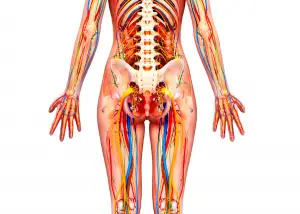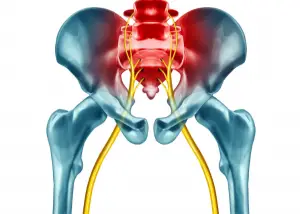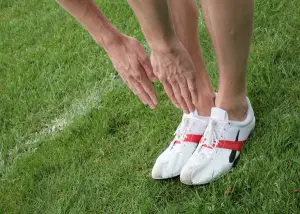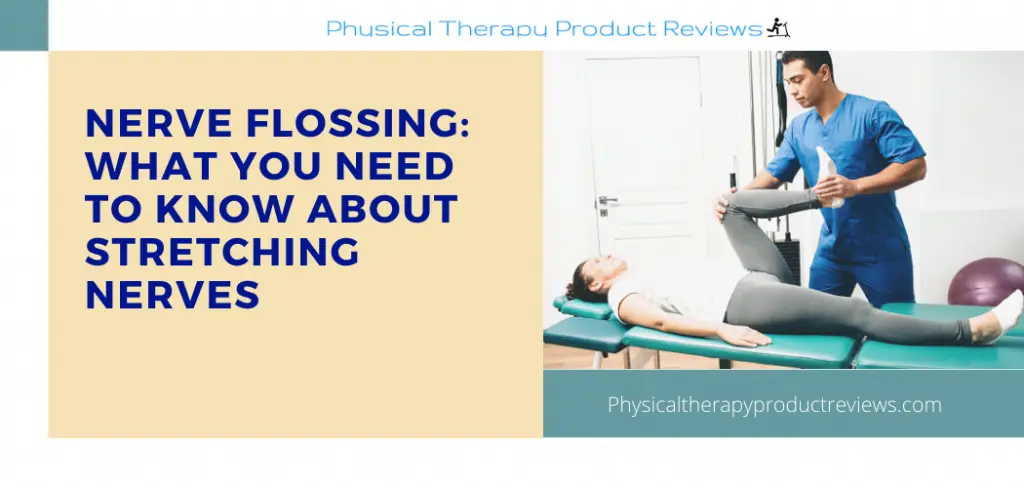Stretching isn’t just for muscles. It turns out that your nerves can benefit from it too! You might not have known that you can improve your mobility and decrease pain by focusing on exercises for your nerves. So, let this guide serve as your introduction to the grand world of Nerve Glides and the wonders they can do!
What are “Nerve Glides”?
 Nerve Gliding, also known as Nerve Flossing, is a method of improving the mobility of your nerves and is a commonly used technique among Physical Therapists to treat many forms of pain.
Nerve Gliding, also known as Nerve Flossing, is a method of improving the mobility of your nerves and is a commonly used technique among Physical Therapists to treat many forms of pain.
Feelings of tightness and tension don’t always originate from muscles and tendons. At times, faulty Neurodynamics, or the movement of your nerves, are to blame. You won’t get very far by employing the standard muscle stretch here. Nerves move in different ways and require different exercises to target.
What’s the Difference Between Stretching Muscles and Nerves?
Muscle tissue is constructed to contract and relax, thus providing motion to the body. Nerves that course through our anatomy are also dynamic tissues, but they don’t move like muscles do. Yet, they too are soft tissues and contribute to flexibility.
A nerve travels through a tunnel-like sheath and functions like a sliding cord back and forth. Instead of stretching like a rubber band, as a muscle would, a nerve is more like a piece of string that glides one direction at a time. Sometimes nerve entrapment can occur, from scar tissue or sedentary behavior, and this can greatly inhibit a nerve’s ability to move!

Thankfully, nerve flossing can have a significant effect on Neurodynamics and thus influence the body’s mobility and comfort with motion.
How Does Nerve Flossing Help?
Nerve glides apply specific directional tension to a nerve and encourage the natural movement within its sheath. This can help eliminate scar tissue and decrease strain.
A standard muscle stretch cannot effectively influence a nerve, as those positions will tug on the tissue from both ends. Instead, a nerve exercise must take into account how a nerve moves. Like a cord! Therefore, nerve flossing functions by keeping one end of the nerve stabilized, and moving a limb in a single direction to elongate the tissue.
Nerve flossing can also help by resetting the nerve environment which can help it stop sending signals of pain to the brain. By stretching nerves it’s been shown to promote improved nerve health, by dispersing tissue fluid and reducing intraneural swelling and pressure.
How-to Glide Guide!
Sciatic Nerve
The sciatic nerve travels from your low back, down your leg, and all the way to your toes. When people have issues with their sciatic nerve, symptoms like shooting pain down the leg, sharp pain in the buttocks, and a cringing back tightness when bending forward can all occur.

Along with patients that have sciatic nerve symptoms, nerve flossing can also be a beneficial exercise for those with low back pain and inflexibility.
Before you start the nerve flossing exercise, test your symptoms:
Stand up tall, then slowly bend over towards your toes.
At what point do you feel pain or tension? Make note of it and complete the nerve flossing exercise.
The Sciatic Nerve Glide:
- Lay down flat on your back with a small bolster under your knees.
- Raise one leg up, with knee bent, and use your hands to hold your leg behind your thigh (if this is difficult for you to reach, you can use a belt to loop around your leg). Keep your head down and relaxed.
- Slowly straighten your knee, until you feel a tension increase in the back of your leg
- Pause and this point and slowly flex your toes towards you – you will feel the tension increase! That’s good and exactly what you want to feel.
- Slowly relax your leg as you return it to a bend.
- Repeat 10x and practice often throughout the day.
All finished? Re-test your symptoms!
Standing back up, repeat the forward bend and notice any differences. You may find an ability to bend further or fewer symptoms with the movement.
There are nerve glides for many areas of the body, including the neck, elbow, wrists, and upper back. These specific exercises are often employed by Physical and Occupational Therapists for related conditions.
How to Do Sciatic Nerve Glides
What to Expect With Nerve Glides:
- Nerve flossing isn’t a comfy hug. It can be uncomfortable! However, you shouldn’t feel any sharp and intense pain.
- You may notice a difference right away! But the improvement will only sustain with regular practice.
- It’s normal to feel a tingling sensation in your foot during the exercise.
What to Avoid with Nerve Flossing
- Do not force your body into a position that causes pain. This can further irritate tissues and worsen your condition.
- Keep your head relaxed during the activity, otherwise, you’ll add undue tension to the nerve and decrease the effectiveness of the exercise.
FAQ About Nerve Glides
Can nerve glides cause damage?
When practiced properly, nerve glides will not cause damage. But just like a muscle stretch, you don’t want to push it too far. Your body will tell you when you’re close to overdoing it. However, if you don’t feel comfortable completing this exercise on your own, seek consultation with a Physical Therapist.
What is the purpose of nerve glides?
The purpose of nerve gliding is to help calm down irritated nerves. Nerve flossing helps decrease the rate of pain signals being sent to the brain and also improves the range of motion within the nerve being flossed. Nerve gliding is a great way to help speed up recovery from most any injury.
How long to hold a nerve glide?
Stretching nerves is a little bit different than stretching your typical muscle. Instead of holding a nerve stretch for 30 seconds or longer like a muscle stretch you want to “glide it.” Hold nerve glides 10-15 seconds at a comfortable stretch and repeat often.
How long does it take for nerve glides to work?
The best part about nerve glides is that you can see immediate improvement in range of motion most of the time.

As the example earlier in the post suggests, try touching your toes and note how close to the floor you get. Then perform 3-5 minutes of Sciatic nerve glides and re-assess how far down you can reach to touch your toes.
Range of motion will often improve immediately but it can take up to a few weeks to have a noticeable change in pain from doing nerve glides.
Can you overdo nerve glides?
Absolutely, like anything else in health and exercise it is easy to overdo. When performing nerve flossing you want to achieve a medium discomfort while performing the exercise but the pain should quickly go away.
If you slam or push the nerve straight too quickly it can cause further nerve irritation.
How often should you do nerve glides?
You should try and perform them multiple times a day if possible. Nerve glides help bring blood to the nervous system which in turn speeds up healing. You can safely perform nerve glides 2-4x a day for more injuries.
Conclusion:
Nerve flossing is a great exercise that can offer immediate results. It’s a wonderful tool to have on hand to treat momentary tightness or chronic conditions. When it comes to mobility, those nerves are just as important as your muscles!
Author Information
Written By: Lisa Woolridge, DPT
After graduating from the University of Texas Health Science Center at San Antonio, Lisa served as a physical therapist in the Army. She treated orthopedic injuries in soldiers and family members, ran fitness testing clinics, and conducted wellness classes. Lisa left the military when she became a mother and remains involved in the medical field through freelance science writing and consulting.
Works Cited:
Amgen PD. Reuteman P. Conservative rehabilitation of sciatic nerve injury following hamstring tear. North American Journal of Sports Physical Therapy. 2010; 5(3): 143-154. https://www.ncbi.nlm.nih.gov/pmc/articles/PMC2971645/
Bhatia S. Bid D, Ramalingam T. Effectiveness of nerve flossing technique in chronic lumbar radiculopathy. Indian Journal of Physiotherapy and Occupational Therapy. 2017; 11(1): 44-49. https://www.researchgate.net/publication/311665261_Effectiveness_of_Nerve_Flossing_Technique_in_Chronic_Lumbar_Radiculopathy
Coppieters MW, Andersen LS, Johansen R, Giskegherde PK, Hoivik M, Vestre S, Nee RJ. Excursion of the sciatic nerve during nerve mobilization exercises: an in Vivo cross-sectional study using dynamic ultrasound imaging. Journal of Orthopaedic and Sports Physical Therapy. 2015; 45(10): 731-737. https://www.jospt.org/doi/full/10.2519/jospt.2015.5743
Other Great Rehab Related Articles
How to Stay Active After Cervical Fractures: Expert Tips and Advice
Dealing with Painful Stairs After Ankle Replacement Surgery
Walking After a Total Ankle Replacement: Tips for a Successful Recovery
Exercises While Non-Weight Bearing After Ankle Replacement: Elevation, AROM, Leg Raises, and More
Ankle Pain with Stairs: Causes and Home Treatment Options
5 Common Mistakes You’re Making After an Ankle Sprain
Disclaimer: The information provided in this post is for educational purposes only. This is not a substitute for a medical appointment. Please refer to your physician before starting any exercise program.







